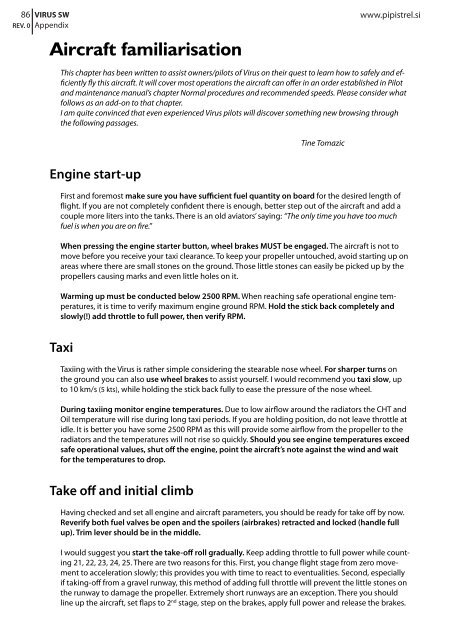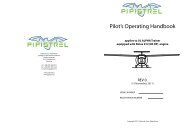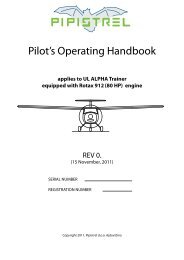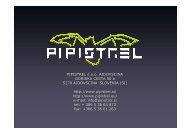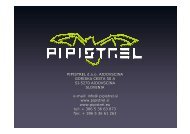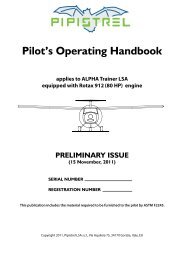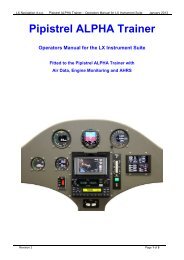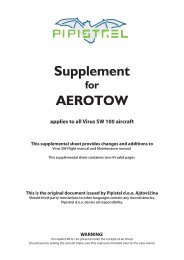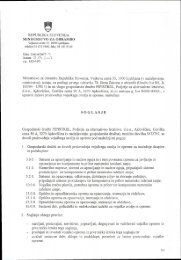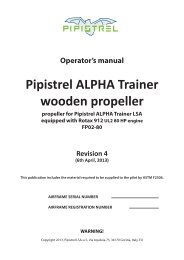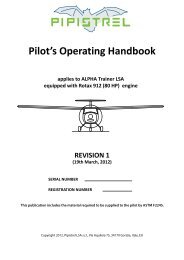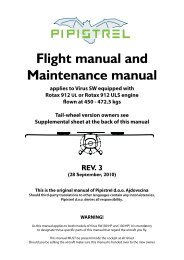Introduction - Pipistrel
Introduction - Pipistrel
Introduction - Pipistrel
You also want an ePaper? Increase the reach of your titles
YUMPU automatically turns print PDFs into web optimized ePapers that Google loves.
86 VIRUS SW www.pipistrel.si<br />
Appendix<br />
REV. 0<br />
Aircraft familiarisation<br />
This chapter has been written to assist owners/pilots of Virus on their quest to learn how to safely and efficiently<br />
fly this aircraft. It will cover most operations the aircraft can offer in an order established in Pilot<br />
and maintenance manual’s chapter Normal procedures and recommended speeds. Please consider what<br />
follows as an add-on to that chapter.<br />
I am quite convinced that even experienced Virus pilots will discover something new browsing through<br />
the following passages.<br />
Tine Tomazic<br />
Engine start-up<br />
First and foremost make sure you have sufficient fuel quantity on board for the desired length of<br />
flight. If you are not completely confident there is enough, better step out of the aircraft and add a<br />
couple more liters into the tanks. There is an old aviators’ saying: “The only time you have too much<br />
fuel is when you are on fire.”<br />
When pressing the engine starter button, wheel brakes MUST be engaged. The aircraft is not to<br />
move before you receive your taxi clearance. To keep your propeller untouched, avoid starting up on<br />
areas where there are small stones on the ground. Those little stones can easily be picked up by the<br />
propellers causing marks and even little holes on it.<br />
Warming up must be conducted below 2500 RPM. When reaching safe operational engine temperatures,<br />
it is time to verify maximum engine ground RPM. Hold the stick back completely and<br />
slowly(!) add throttle to full power, then verify RPM.<br />
Taxi<br />
Taxiing with the Virus is rather simple considering the stearable nose wheel. For sharper turns on<br />
the ground you can also use wheel brakes to assist yourself. I would recommend you taxi slow, up<br />
to 10 km/s (5 kts), while holding the stick back fully to ease the pressure of the nose wheel.<br />
During taxiing monitor engine temperatures. Due to low airflow around the radiators the CHT and<br />
Oil temperature will rise during long taxi periods. If you are holding position, do not leave throttle at<br />
idle. It is better you have some 2500 RPM as this will provide some airflow from the propeller to the<br />
radiators and the temperatures will not rise so quickly. Should you see engine temperatures exceed<br />
safe operational values, shut off the engine, point the aircraft’s note against the wind and wait<br />
for the temperatures to drop.<br />
Take off and initial climb<br />
Having checked and set all engine and aircraft parameters, you should be ready for take off by now.<br />
Reverify both fuel valves be open and the spoilers (airbrakes) retracted and locked (handle full<br />
up). Trim lever should be in the middle.<br />
I would suggest you start the take-off roll gradually. Keep adding throttle to full power while counting<br />
21, 22, 23, 24, 25. There are two reasons for this. First, you change flight stage from zero movement<br />
to acceleration slowly; this provides you with time to react to eventualities. Second, especially<br />
if taking-off from a gravel runway, this method of adding full throttle will prevent the little stones on<br />
the runway to damage the propeller. Extremely short runways are an exception. There you should<br />
line up the aircraft, set flaps to 2 nd stage, step on the brakes, apply full power and release the brakes.


